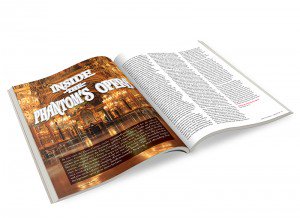As you enter the Opera Garnier, you’re immediately struck by an aura of mystery. Crystal candelabras illuminate gilded cherubim with an ethereal, golden glow throughout the expansive halls, and you feel like you’ve stepped into a dream. You make your way to the iconic double staircase, climbing its white marble steps. As you take your seat, you look up to see the same chandelier that once crushed a concierge dangling overhead. The overture begins and you sneak a glance at box five, hoping and dreading that the legendary opera ghost will show his face.
If you’re a lover of theater or literature (or even just a Gerard Butler fan) you’ve probably heard the century-old tale of Paris’ Opera Garnier and its phantom. A beloved story known across nations and generations, Gaston Leroux’s novel The Phantom of the Opera has been retold in a number of ways, on a number of stages. The most notable of these interpretations is the Broadway musical adaptation by Andrew Lloyd Webber, which has been keeping the Phantom alive since 1986. No matter what creative license is taken, the basic story-line remains the same: disfigured musical genius meets girl, attempts to win girl’s heart with complimentary voice lessons, threatens certain disaster if girl isn’t given a leading role, and ultimately loses girl to another man who is sane, has a title, and isn’t squatting at an opera house. The characters of Erik the phantom, Carlotta the diva, Raul the knight (or rather, count) in shining armor, and Christine the innocent soprano parade through the play within a play telling the beloved tale full of trap doors and underground lairs, senseless murders in the name of “love,” poorly secured lighting structures, and an air of magic and mystery that has enthralled readers and audiences alike for over a century.
 This world of ghosts and gaslights may seem like a fantastically imaginative tour de force of Classic literature, and it is. Yet, a surprising amount of historical evidence suggests that maybe the events of Leroux’s 1910 Phantom of the Opera are not so far from the truth.
This world of ghosts and gaslights may seem like a fantastically imaginative tour de force of Classic literature, and it is. Yet, a surprising amount of historical evidence suggests that maybe the events of Leroux’s 1910 Phantom of the Opera are not so far from the truth.
To find the real story behind the Phantom of the Opera, one must return to its original stage: the Paris opera house, also known as the Palais Garnier.
Would you like to discover the Phantom’s opera with your students? Take a look at the Paris, City of Light tour or call 1.888.310.7120.

